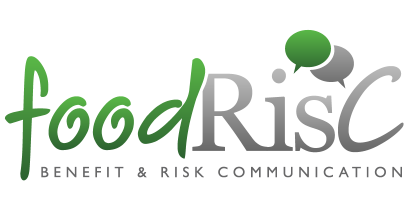New e-resource centre to facilitate effective communication on food risks and benefits
Last Updated : 09 February 2013Today, many communicators send out news about food risks and benefits through a variety of channels. For consumers, it can be difficult to make sense out of this, especially if the messages are conflicting. The European Commission-funded FoodRisC project was a three-and-a-half-year activity to understand current barriers about communicating food risks and benefits, and to identify potential solutions. By comparing the use of traditional and social media within the European Union, and evaluating the public’s information seeking behaviour and perceptions of food risks and benefits, FoodRisC researchers developed an innovative e-resource centre to assist key communicators in effective dissemination about food risks and benefits.
Understanding perceptions of food risks and benefits
The first step in the FoodRisC project involved qualitative research to explore understanding of food risks and benefits. FoodRisC researchers conducted in-depth interviews with 99 European consumers, 33 experts and 38 stakeholders in the food chain (including food industry, consumer organisations, retailers and non-governmental organisations). To ensure a European perspective, participants from Belgium, Ireland, Italy, Latvia, the Netherlands, and Spain were interviewed.
Stakeholder and expert opinions about social media for food risk and benefit communication were analysed with a ‘Strengths-Weaknesses-Opportunities-Threats’ (SWOT) analysis. The participants defined the core strengths of social media as speed, audience interaction, and accessibility. The fact that information on social media can be anonymous and unidentifiable is considered a weakness. Nevertheless, stakeholders and experts consider social media to be a useful opportunity to create communities and engage consumers. The possible spread of incorrect information and the time-consuming nature of becoming a social media expert are examples of threats. Overall, stakeholders and experts would like to learn more about the use of social media for food risk communication, but are cautious, and prefer to use traditional media channels such as online media, print, television and radio.1
Social media offer a new means to receive and provide information
In 2013, the Web has over two and a half billion users, and it has evolved rapidly from a world where users consulted it for information (Web 1.0) to a world where users are now able to generate and share information themselves (Web 2.0), e.g. Facebook, Twitter, Wikipedia and YouTube.2 Thus, reporting or commenting on news is no longer the sole remit of professionally employed journalists working for media organisations. If users wish to, they have the possibility to write and disseminate news as a ‘citizen journalist’.3
By conducting interviews in four European countries, FoodRisC researchers investigated the identities and practices of both professional and citizen journalists who reported on food risks and benefits. In many respects, similarities were observed between professional journalists and citizen journalists who have expertise in their subject area (e.g. expert bloggers), compared to citizen journalists who have no specific expertise (e.g. hobby bloggers). One of the main challenges for communicators is to send out messages in a way that meets the needs of their audiences. Journalists in particular are an important group to take into account as they are involved not only in the dissemination of the message to a wider audience, but also in the interpretation and framing of the information. Journalists have the potential to act as an ‘agenda builder’ and to impart influence on their audience.
FoodRisC researchers investigated media coverage of the 2008 Irish dioxin crisis in pork, the 2010 German dioxin crisis in pork, chicken and eggs and the 2011 German EHEC (enterohaemorrhagic Escherichia coli) crisis in sprouted seeds (specifically fenugreek seeds). Findings highlight the importance of online news, blogs and microblogs (i.e. Twitter) as communication channels. Twitter was primarily used to inform readers of breaking news and to refer a reader to more detailed information – usually online news, via links embedded in the tweet. Results from both the 2008 Irish dioxin crisis and the 2010 German dioxin crisis also show that social media users respond very quickly to a food crisis; however, compared to traditional media they lose interest more quickly. But, due to the speed of reporting and the ease of onward transmission, e.g. re-tweets, it is essential that any misleading or incorrect information is corrected quickly. This is particularly important considering the long period of time that information can still be found on the internet via a search engine, this is known as the ‘Echo-Chamber Effect’.
FoodRisC researchers suggest that monitoring these online conversations should form an integral part of an organisation’s communication strategy. Monitoring can provide insights not only of ‘what is being discussed’ but also ‘who is discussing it’. The latter is particularly important as it can lead to better understanding of the flow of information between people.4
Traditional and online media still have a role
Understanding consumer ‘search’ behaviour is key to improving the practice of food risk and benefit communications. A web-based survey was conducted in nine European countries: Belgium, Germany, Ireland, Italy, Latvia, the Netherlands, Portugal, Spain and the UK.
The survey found that there are mainly two ways that people acquire information. When a food incident occurs, some people look for additional information in traditional mass media. Television news is still the channel consumers in Europe prefer the most as a source of information about a food incident. Other people will take a more active approach and turn to the Web. Search engines, such as Google, are channels that consumers in Europe are most likely to use. Consumers are less likely to visit social media to find out more about food issues and they consider the information in social media to be less useful than in other channels.
In addition, the survey highlighted three main motives for consumers to search for information on food issues. Consumers look for information when they consider the issue to be relevant to them, based on their personal situation. They look for information when they would generally like to be well informed and reflect on the meaning of information for their own lives. Consumers are also encouraged to keep up-to-date with food issues by their social connections.
How do consumers respond to conflicting food information?
FoodRisC researchers also looked into consumer reactions to new, conflicting and uncertain information. Consumer responses were explored using an innovative online tool called VIZZATA. The VIZZATA tool is an opportunity for participants to engage with researchers by asking questions and providing comments.
In the study, FoodRisC researchers used VIZZATA to understand consumer questions and concerns after the Food Safety Authority of Ireland (FSAI) announced on 15 January 2013 that horse and pig DNA were found in beef burgers. Forty two UK and Irish consumers – all meat eaters who shopped in at least one of the affected retailers – submitted a total of 292 questions and comments in a study which started four days after the story broke, on 19 January.
Results showed that consumers were mainly concerned that ingredients on labels did not match the contents of the products. There was very little evidence of concerns about health risks from foreign animal DNA after the FSAI’s announcement. Many participants were interested to know the cause of the contamination and why they were not told earlier about the results of the burger tests.5
Food risks and benefits appear to be topics which lend themselves to consumer online deliberation. Results of VIZZATA studies can be useful for tailoring subsequent strategic communications. The tool enables researchers to reply to participants, share information and invite them to respond in turn to this.
"The global nature of today's food chains asks for a global approach in communicating food-related risk and benefit issues,” said FoodRisC researchers in a peer-reviewed article published in Trends in Food Science & Technology.
Best practices combined into a ‘one-stop-shop’ e-resource centre
Based on the project’s research and stakeholder dialogue, FoodRisC researchers developed an innovative e-resource centre to assist communicators in producing responsive, authoritative and meaningful communications about food-related risks and benefits.
This e-resource centre includes six specific sections.
- ‘Evaluate your situation’ summarises factors identified, by both academics and practitioners, as being crucial to risk communication decision-making. Reflecting on the purpose of the communications strategy is a key factor to keep in mind when deciding on future activities.
- ‘Understand your audience’ offers guidelines and tips to tailor communication according to the needs of the target audience. Besides knowing who your audience is, it is important to identify key influencers and increase communication effectiveness towards them. This section includes an interactive, online tool to help decide the best research method, to gather knowledge about the audience and to respond to potential research questions.
- ‘Create your message’ gives tips on how to translate science accurately into relatively simple language that risk managers, stakeholders and wider audiences can understand, in order to avoid misinterpretations.
- ‘Media channels’ identifies the strengths and weaknesses of different communication channels (both social and traditional media), and offers practical guidance, such as ‘how to get started’, and tips to assist best practice.
- ‘Monitor communications’ presents tips and guidelines on how to monitor online conversations, which makes it possible to detect upcoming issues at an early stage and to learn more about networks of people involved in discussions and content creation.
- ‘Public involvement’ enables understanding of the thoughts and needs of both consumers and stakeholders through the VIZZATA tool, which is essential to maximise the effectiveness of food risk and benefit communication.
The interactive FoodRisC e-resource centre provides relevant information and guidelines for a range of professional communities and stakeholders in different scenarios of food-related risk communication, and suggests concrete strategies for action. This was the ultimate goal of the FoodRisC project.
Further information
- www.foodrisc.org
- http://resourcecentre.foodrisc.org
FoodRisC is coordinated by University College Dublin and funded under the Seventh Framework Programme of the European Commission; grant agreement number: 245124. The FoodRisC consortium is comprised of experts in key fields relevant to food risk and benefit communication, research institutes, consumer organisations, and SMEs in nine EU Member States: Ireland, UK, the Netherlands, Belgium, Latvia, Portugal, Germany, Italy and Spain.
References
- FoodRisC website, News section. Podcast: Dr Wim Verbeke – Ghent University, Belgium
- International Telecommunication Union (2013). The world in 2013, ICT Facts and Figures: Internet Users in 2013. Geneva, Switzerland
- Shan L, Regan Á, De Brún A, et al. (2013). Food crisis coverage by social and traditional media: A case study of the 2008 Irish dioxin crisis. Public Understanding of Science. Published online ahead of print 1 Feb 2013. DOI: 10.1177/0963662512472315
- Rutsaert P, Regan Á, Pieniak, et al. (2013). The use of social media in food risk and benefit communication. Trends in Food Science & Technology 30(1):84–91
- FoodRisC press release “Health risks were not consumers’ first concern over horse meat contamination.” Published 20 February 2013

